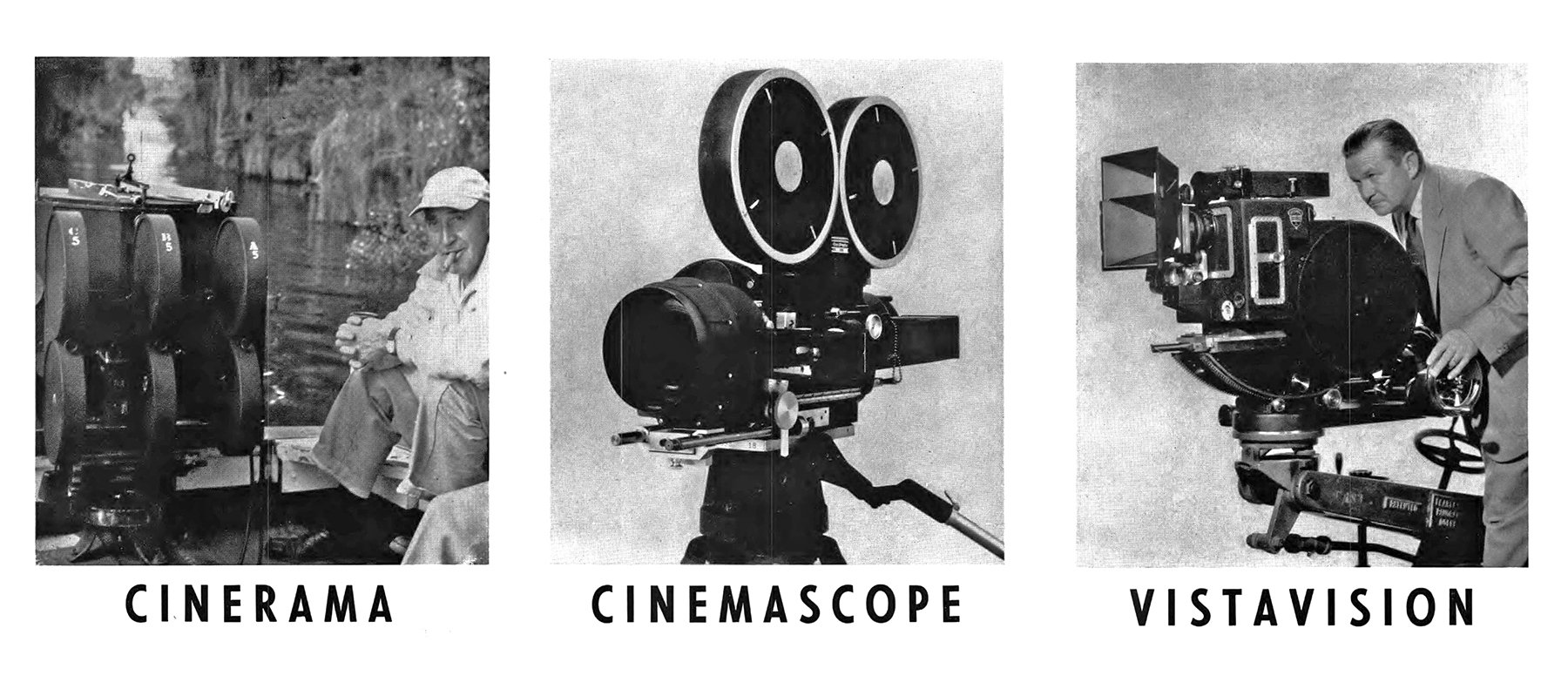
Summary of Current Wide-Screen Processes
Taking a look at the six different types of wide-screen shooting options currently in use.
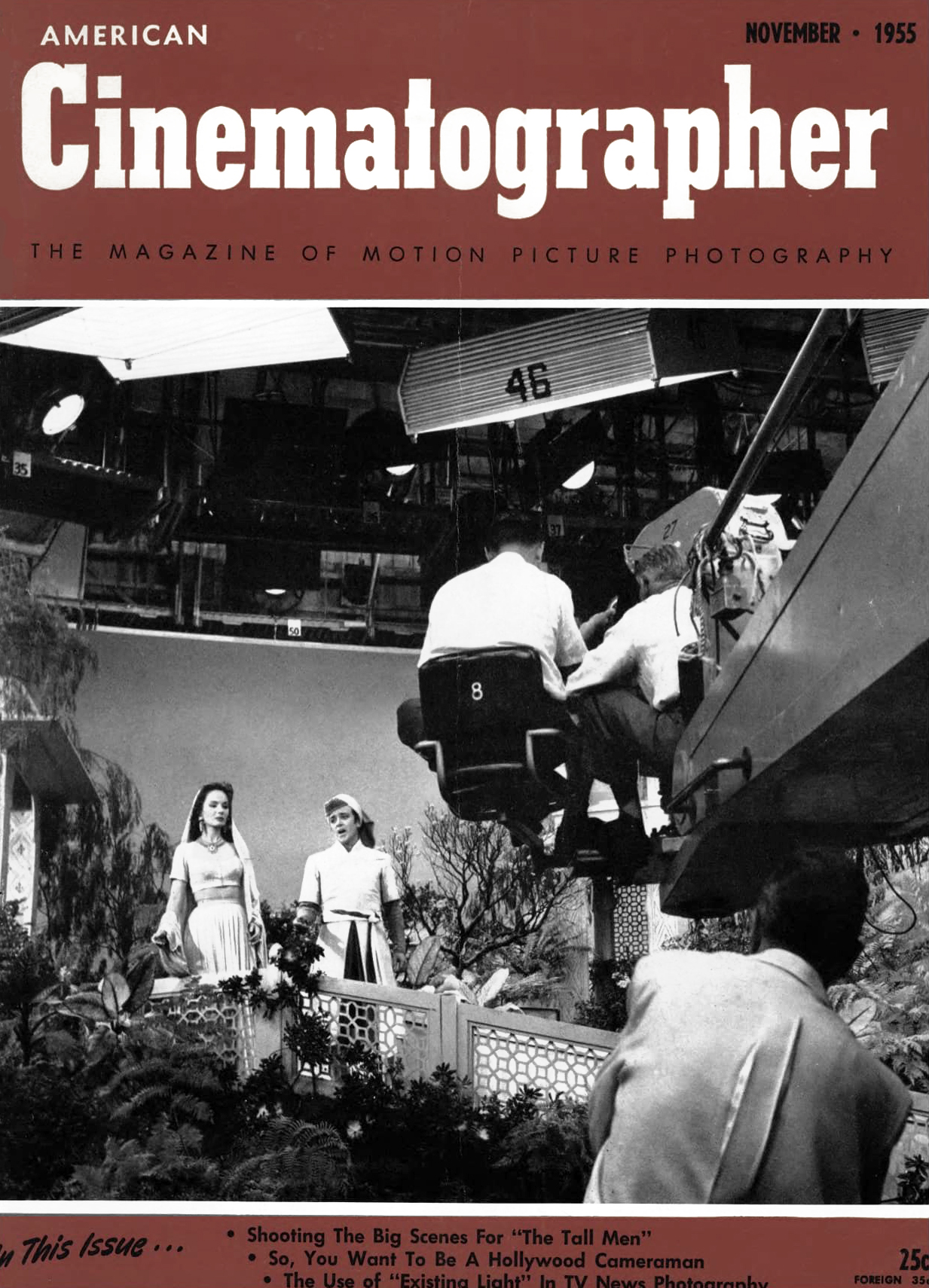
The development of wide-screen motion picture systems has resulted in six well-established methods now currently in use in Hollywood. A seventh, Panavision, is about to go into use at Metro-Goldwyn-Mayer studio in Hollywood.
For the edification of our readers, the editors have presented here both in pictures and text, a summary of the six systems. With exception of the Cinerama film clips, which had to be reduced slightly in order to fit the space, all film reproductions on these pages are full size and show the comparative negative sizes used by each of the systems, and also any unusual placement of the image, as in VistaVision, which has the picture in horizontal position instead of the vertical, which is standard with all the others.
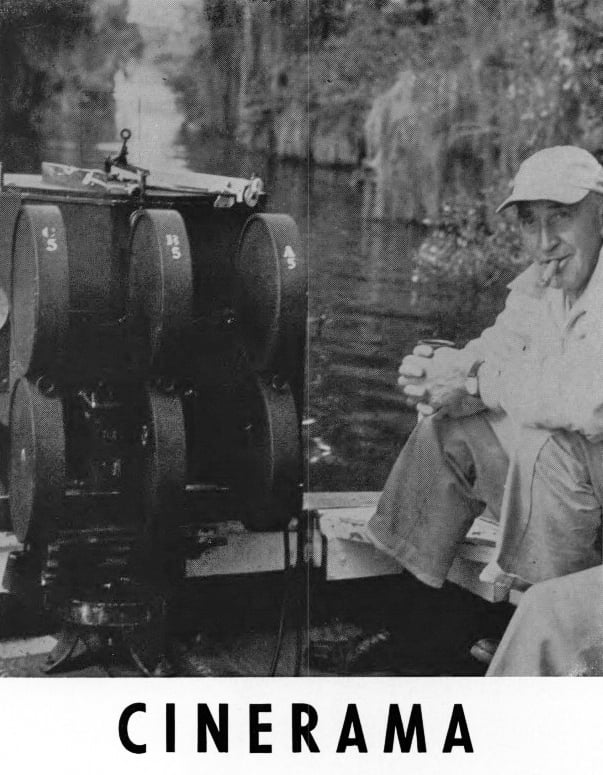
Camera: The Cinerama camera is actually three cameras in one in that it photographs simultaneously three strips of 35mm negative. The resultant three prints when projected form a wide-screen picture that covers a field of vision 146°wide and 55 ½°high. The photo above shows the camera from the rear and reveals the three film magazines. Above is Harry Squire, ASC, the cinematographer who photographed the first Cinerama production. Cinerama is the outgrowth of the famous wartime Waller Gunnery Trainer, which utilized a five-lens camera of unique design and five projectors to show airplanes realistically on a large curved screen. The Cinerama three-lens camera is a modification of the Waller development. Any of the standard heavy-duty tripods as well as conventional dollies and cranes may be used with the camera.
Lenses: The eyes of the 150-pound Cinerama camera are three matched lenses of 27mm focal length, set at angles 48°apart. Each lens records one third of the total width of the scene upon one of the three standard 35mm negatives. The lines of sight of the three lenses converge and cross at a point 11/16". in front of them, where a single revolving disc shutter serves them all, and assures synchronization of exposures. Simultaneous focusing of all three lenses is accomplished through a single control, while diaphragm settings on all three lenses are similarly set simultaneously by means of another control knob.
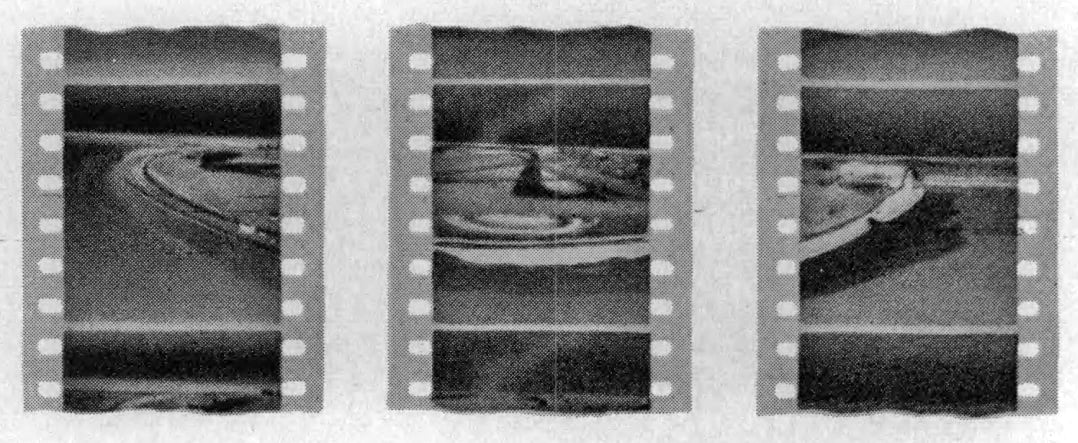
Film: The Cinerama camera takes any 35mm negative stock, black-and-white or color. The Cinerama productions made to date have been photographed on Eastman Color negative and processed by Technicolor Motion Picture Corp. Individual Cinerama film frames are 1½ times standard height—that is, 6 sprocket holes in length instead of the conventional four. And since three film strips are used, this means that the total amount of film used for a given production is 4½ times that of a standard 35mm motion picture production of comparable screening time. As yet Cinerama cameras are not generally available to other film producers, being used exclusively in the making of Cinerama productions.
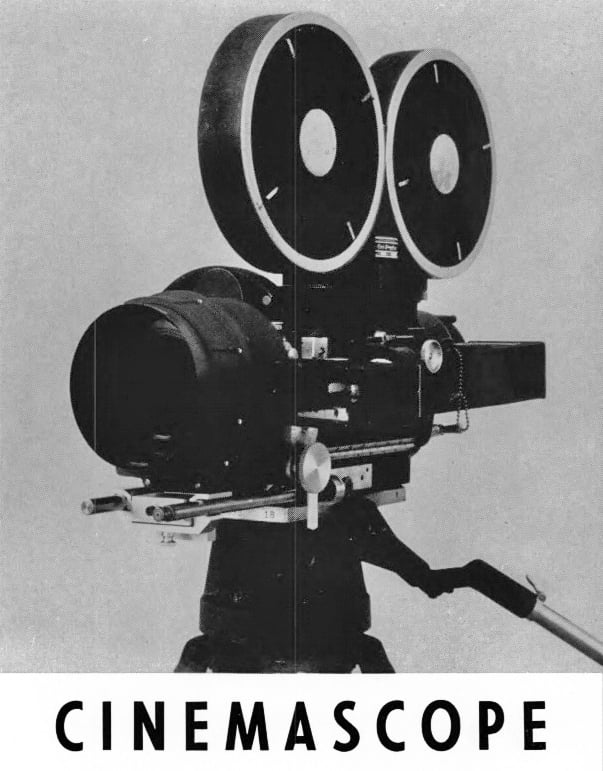
Camera: CinemaScope is essentially a copyrighted trade name for a system of wide-screen film production developed by 20th Century-Fox Studio. The photography involves no special camera but rather depends upon the use of anamorphic lenses for producing the picture image which, when “unsqueezed” during the projection process, produces a picture with an aspect ratio 2.55 to 1. The 20th Century Fox CinemaScope lenses may be used with almost any standard 35mm motion picture camera equipped with appropriate adapters, and having the aperture enlarged to the CinemaScope dimensions.
Lenses: The whole development of CinemaScope has centered in the camera lenses. Following acquisition of the first anamorphic lens from the French optical engineer Henri Chrétien, Fox launched the first CinemaScope production, The Robe. Studio engineers, the meanwhile, sought to improve upon the lens and took the problem to Bausch & Lomb Optical Company. The initial Chrétien CinemaScope lens was an “attachment” or auxiliary lens — one that was mounted before the regular camera lens. Subsequently, Bausch & Lomb brought out an improved CinemaScope lens which incorporated the anamorphic lens and the camera lens in one unit. Besides improved optical quality, the new lens did away with the necessity of having to make adjustments on two lenses each time a shot was to be filmed. Bausch & Lomb single-unit CinemaScope lenses today are available in five focal lengths: 35mm, 40mm, 50mm, 75mm and 100mm. 20th Century-Fox also makes the lenses available to other studios, and thus CinemaScope-type film productions are today turned out by such studios as Metro-Goldwyn-Mayer, Warner Brothers, Columbia, and others, despite the fact that some of these studios have or are developing their own wide-screen systems.
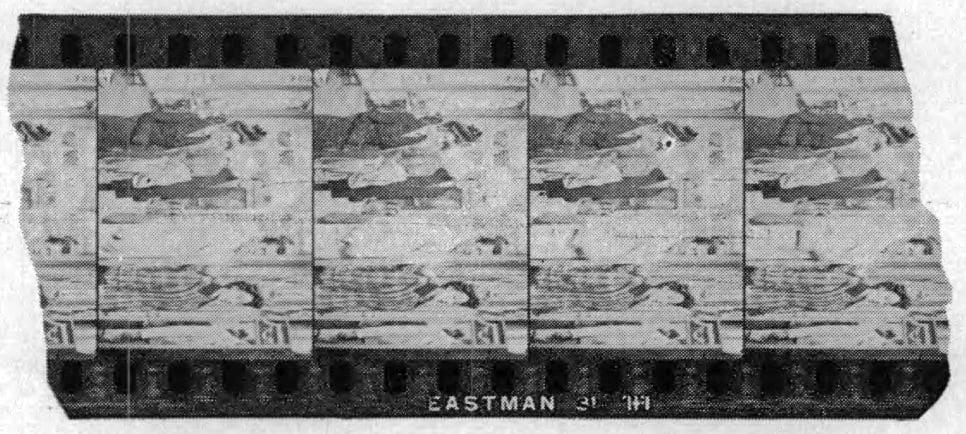
Film: With one exception (the Fox 4x-55mm system) all CinemaScope productions are photographed on 35mm film — usually Eastman Color negative. DeLuxe Film Laboratories, a 20th Century-Fox subsidiary, processes most all of the studio’s CinemaScope negatives and makes the prints. Previously, the work was done by Technicolor, who continues to process and print anamorphic negatives for other studios.
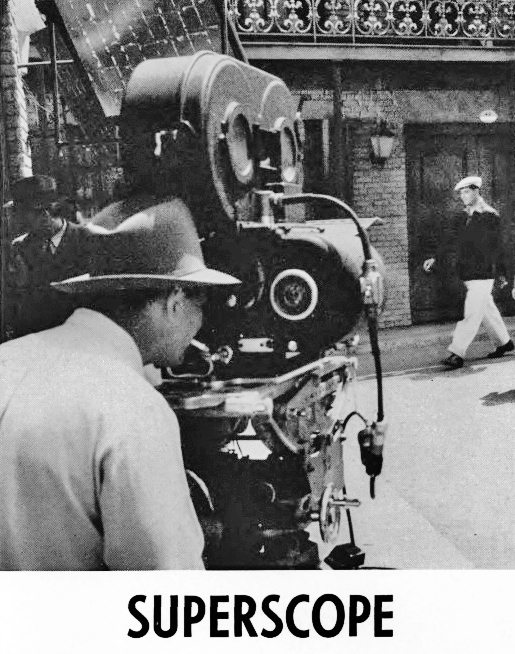
Camera: Unlike with most wide-screen systems, Superscope requires no special camera. Basically an anamorphic process, the squeezing of the image is done in the laboratory, after the negative is shot. The only requirement in the photography is that certain limitations be observed in framing the action —i.e., the CinemaScope format must be observed in framing, and this is done by appropriately masking the camera finder top and bottom. Thus, in the laboratory, after the negative is developed, this area is optically printed with the aid of Superscope anamorphic lenses, producing a print like the one below, at right. The film clip opposite shows the negative area covered by the camera, but does not show the top and bottom portions masked off — nor are they actually masked off in the photography.
Where the standard CinemaScope picture has an aspect ratio of 2.55 to 1, the developers of Superscope have settled on an aspect ratio of 2 to 1. The squeezed print therefore is .715" by .715", leaving a blank area at one side, as may be seen in the film clip reproduction.
Lenses: Inasmuch as any standard 35mm camera, which provides an adequate viewfinder, may be used for shooting a picture for the Superscope process, there are no specifications nor limitations as to the lenses that may be used in the photography.
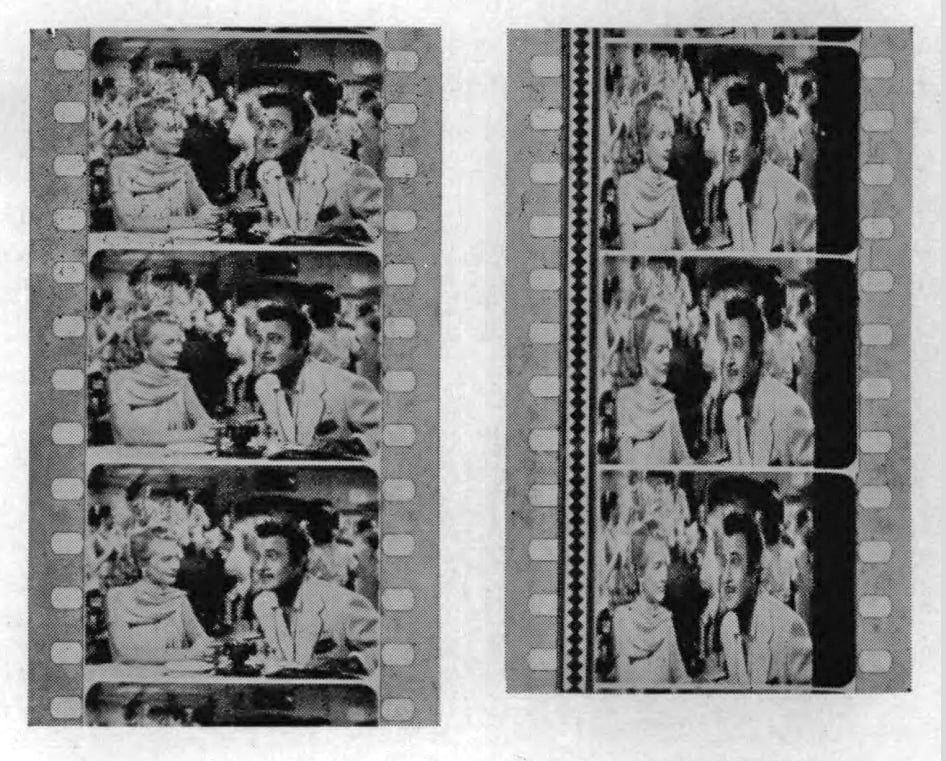
Film: Eastman Color negative is the stock most generally used for Superscope prints; however, the process works equally well with black-and-white films.
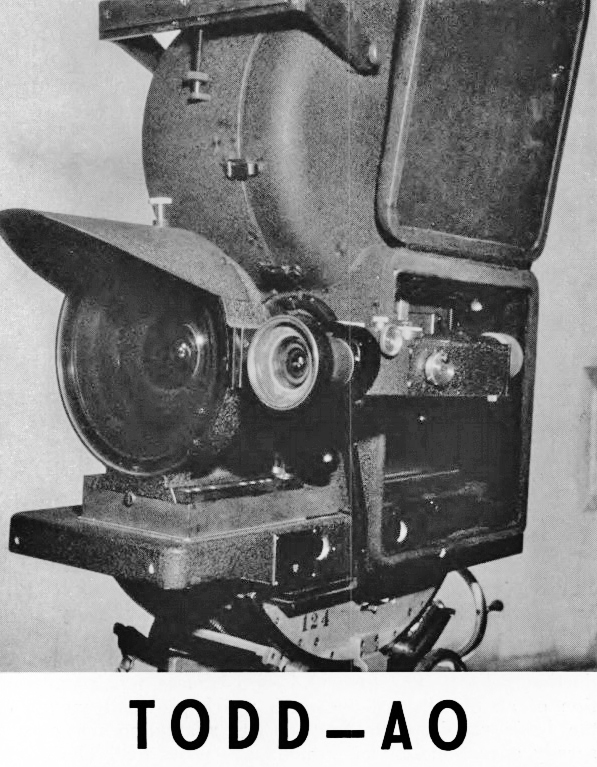
Camera: The first Todd-AO cameras were modified Thomas Color cameras, designed for use with 70mm film. The sprockets, movement, etc., were altered by Mitchell Camera Corporation to take standard Eastman 65mm film. Each frame is 5 sprocket holes in height. Another feature is the higher film speed travel — 30 frames per second as compared to 24 for standard 35mm cameras — which was found to smooth out action on the larger screen. Film magazines, which are demountable, take 1,000' rolls of film. Only slightly larger than the Mitchell 35mm camera, the Todd-AO camera may be mounted on any standard tripod, dolly or crane. Mitchell Camera Corporation is presently engineering a completely new Todd-AO camera which will incorporate the well-known Mitchell movement, provide for rackover and include other Mitchell features.
Lenses: As with conventional 35mm motion picture cameras, the Todd-AO camera takes a range of lenses of different sizes; but unlike the lenses used on 35mm motion picture cameras, which vary in focal length, the Todd-AO lenses are classified according to the angle of coverage. Four lenses cover everything from a closeup to distant scenic shots. These range from the huge 128° “bugeye” wide-angle lens — so called because of its enormous front element (See Photo.) — down through the 64, 48°, and 37° lenses. At present two separate Todd-AO cameras are required in shooting a production: one having the 128° lens permanently attached, and the other designed to take the other three lenses interchangeably. All Todd-AO lenses have a short, sharp vanishing point, and the depth of field is quite shallow — which means that the camera operator really has to be on his toes when moving crane and dolly shots are being photographed.

Film: Todd-AO cameras take Eastman Color negative which is slit and perforated in 65mm width by the manufacturer. The picture area extends almost to the sprocket holes on each side and the equivalent of five sprocket holes in height. Release prints are made on 70mm stock, the additional width providing for the soundtrack.
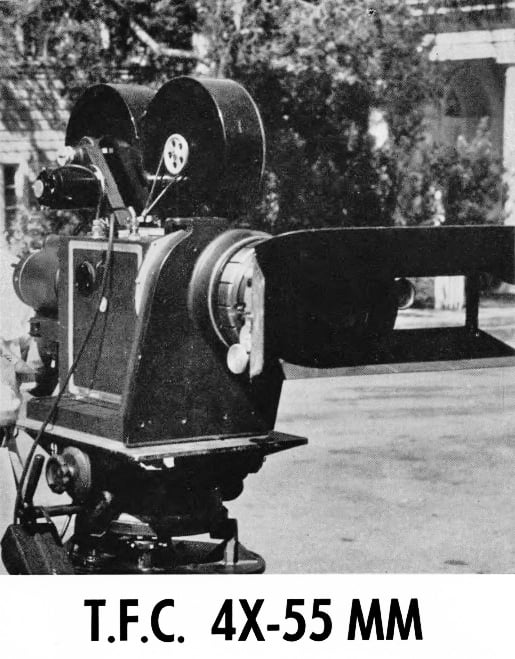
Camera: Like CinemaScope, the T.C.F. 4X-55mm camera is an exclusive Twentieth Century-Fox development. “4X-55MM” means that the camera uses 55mm film (actually it is 55.625mm in width) and the frame provides a 4X, or four times greater picture area than 35mm. The first 4X-55mm camera was an adaptation of an old discarded camera which provided enough of the basic requirements to make its adaptation not only a speedy operation but an economical one as well. The necessary mechanical work was done on the T.C.F. lot by studio engineers. The camera, which employs an improved CinemaScope lens, makes possible, along with the wider negative, greatly improved CinemaScope wide-screen photography — much clearer and better defined pictures and almost a total elimination of the distortion common to so many widescreen processes. New 4X55mm cameras completely engineered from top to bottom are presently being started by a prominent camera manufacturer.
Specifically, what is achieved by this new widescreen camera and 55mm film is (1) a larger-area negative for use in making direct 55mm CinemaScope release prints of major productions for roadshow type of theatre presentation, and (2) by optical reduction of the 55mm negative, a 35mm CinemaScope print greatly improved in quality over that achieved when the negative is photographed on 35mm film. This is due to the reduction of the magnification factor which results by optically reducing the print from a larger original negative. (See “CinemaScope on 55mm Film,” October, 1955, American Cinematographer. — EDITOR.)
Lenses: The Twentieth Century-Fox 4X-55mm camera utilizes an entirely new type anamorphic lens designed by the studio’s New York research department in collaboration with Bausch & Lomb Optical Company engineers. Like the dual-purpose, single-unit Bausch & Lomb anamorphic lenses in present use for 35mm CinemaScope photography, the lenses for the 4X-55mm cameras incorporate the same simplicity of focusing and mounting. The focal lengths are 75mm, 100mm and 152mm.
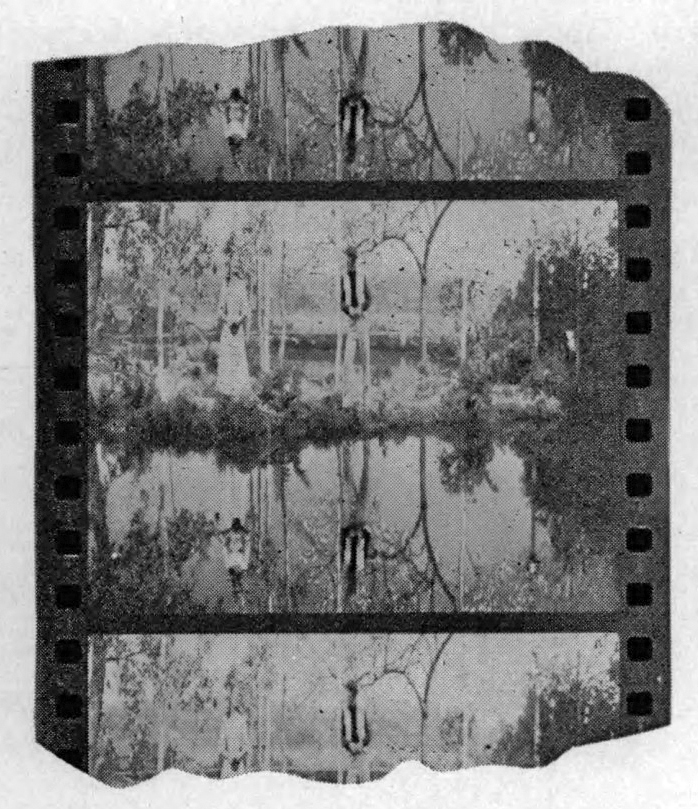
Film: When the first 4X-55 camera was put into use, blank Eastman Color negative stock was slit in widths of 55.625mm, then perforated with a machine which was constructed especially for the purpose by T.C.F. studio engineers. Today, Eastman Color negative in 55.625mm widths, properly perforated, is being supplied in quantities by Eastman Kodak Company.
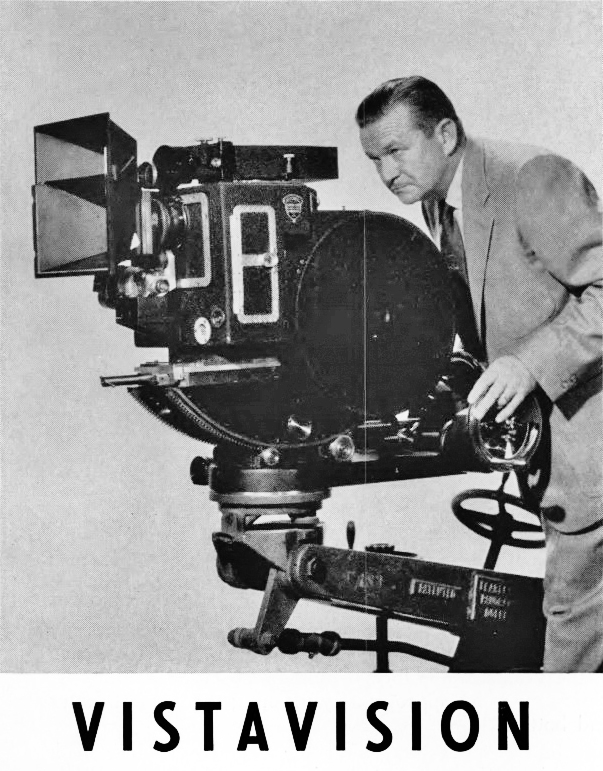
Camera: The outstanding feature of the VistaVision camera is the fact the negative travels past the lens horizontally instead of the conventional vertical manner. This makes possible recording a pictures area 8 sprocket holes in length, and providing a large negative image which undergoes a measure of reduction in printing the positive release print. It also makes possible the screen aspect ratio of 1:66 to 1, which Paramount Pictures Corp. established sometime ago as the most ideal screen size for the majority of the nation’s theaters. VistaVision is Paramount’s answer to Fox’s CinemaScope. The first VistaVision camera was a hasty adaptation of an old abandoned William Fox “Natural Color” System camera, developed in the late ’20s by the William P. Stein Co., of New York. The results achieved with it by Paramount in photographing White Christmas led the studio to design an improved VistaVision camera, which subsequently was manufactured by Mitchell Camera Corporation, makers of the world’s most renowned studio cameras.
Present VistaVision cameras are compact in size, have 2,000' magazines — one on each side of the camera instead of the conventional double chamber magazine on top. Camera width is a mere 13" while the overall length is 25⅜" and the height, 20¾". Approximate gross weight of camera, including 2,000' film load, is 105 pounds.
The film moves from right to left a distance of 8 perforations per frame or exposure. The movement is a modification of the well-known Mitchell NC link movement. The pulldown movement (actually the “pull-across” movement) has been shortened to provide a 190° exposure time. The movement racks up and down for alternate viewing of the scene through the lens and photographing. Racking is controlled by the operator through a lever at rear of the camera. (For a more complete description see “VistaVision Moves Forward,” page 552, November, 1954, American Cinematographer. — EDITOR.)
Lenses: All lenses used on VistaVision cameras have been specially designed to cover the double-frame area of the negative. All are mounted in rotating focusing barrels, are in ball-bearing mounts, and are calibrated for T-stops. Range of lenses consists of 21mm, 28mm, 35mm, 44mm, 50mm, 75mm, 85mm, 100mm, and 152mm. With the VistaVision cameras, standard focal length lenses of 50mm and 35mm can be used to gain wider angle photography than when used with standard 35mm cameras. A 50mm lens covers an angle of 39° in VistaVision as compared to 24° in standard 35mm photography. A 35mm lens on a VistaVision camera covers an angle of 54°as compared to 33°in standard 35mm cameras.

Film: VistaVision cameras take any 35mm negative stock, black-and-white or color.






